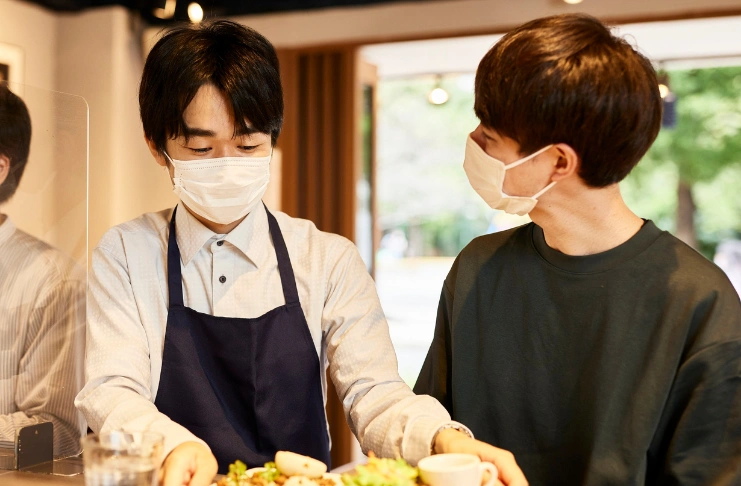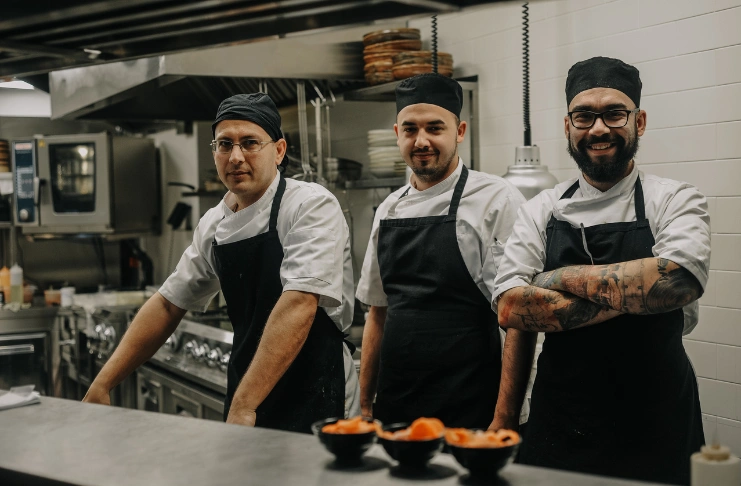The quality of your staff defines the quality of your restaurant. A well-trained team is the backbone of your restaurant’s operational consistency, guest satisfaction, and long-term profitability.
Yet many operators underestimate what effective training really looks like. They think they’re set after just onboarding a candidate. But real training constitutes culture, accountability, and execution at every shift.
This guide offers a comprehensive restaurant staff training manual, an actionable checklist, and a clear framework to help you build, train, and retain a high-performing team.
The Foundation of Restaurant Training Success

Creating a successful restaurant training program requires understanding the unique challenges your staff might be facing today. High turnover rates (averaging around 79.6%), diverse skill levels among new employees, and the fast-paced restaurant environment all contribute to training complexity.
However, establishments that overcome these challenges through systematic approaches to employee training see significant returns on their investment.
The restaurant training manual is the cornerstone of any effective staff training program. This document provides consistency across all training efforts, ensuring that every team member receives the same foundational knowledge regardless of who conducts their training.
Without this standardized approach, training quality varies dramatically, leading to inconsistent service delivery and customer satisfaction issues.
Research consistently demonstrates that restaurants with structured training programs outperform those without formal systems. Such establishments experience lower turnover rates, higher customer satisfaction scores, and improved profitability.
Investing in staff training pays dividends through customer loyalty, reduced recruitment costs, fewer operational mistakes, and enhanced reputation in the marketplace.
Understanding Your Training Needs

Before developing any restaurant training program, conduct thorough assessments of your specific training requirements. Consider your concept, target demographic, service style, and operational complexity. A casual dining establishment has different training needs than a fine dining restaurant, just as a quick-service location requires different skills than a full-service establishment.
This assessment process will technically involve evaluating current staff performance, identifying gaps in service delivery, and analyzing customer feedback patterns. It will ensure that training resources focus on areas with the greatest impact on overall performance.
You must also consider regulatory requirements, local health codes, and industry best practices when designing your training approach.
Mind that menu complexity significantly influences training requirements. Establishments with extensive wine lists, complex preparation methods, or specialized dietary accommodations need more comprehensive menu training than those with simplified offerings.
Similarly, restaurants operating in multiple locations must balance consistency with local market adaptations in their training materials.
Building Your Restaurant Staff Training Manual

The development of a detailed training manual requires careful planning and systematic organization. This document serves as the primary reference for all staff training activities and must be comprehensive enough to address every aspect of job performance while remaining accessible and practical for daily use.
Establishing Company Foundation
Begin by establishing your restaurant’s foundational elements that guide all operational decisions and staff behavior. This mission statement will serve as the north star for employee actions, providing context for why specific procedures and standards exist. This isn’t merely corporate messaging but practical guidance that helps your staff members make appropriate decisions in various situations.
Your restaurant’s core values must translate abstract concepts into concrete behaviors that your staff members can observe and emulate. For example, if hospitality represents a core value, define what hospitality looks like in specific interactions, from greeting customers to handling complaints.
Include your company history and background information to help new team members understand your restaurant’s journey and vision for the future. This context will create an emotional connection and investment in your establishment’s success.
Staff members who understand your restaurant’s story are more likely to create memorable dining experiences and become ambassadors for your brand, sharing positive experiences with customers and contributing to the overall guest experience.
Defining Roles and Responsibilities
Create clear job descriptions that eliminate confusion and establish accountability throughout your organization.
Each position requires specific documentation that outlines daily responsibilities, performance expectations, and advancement opportunities. This will serve multiple purposes: it will guide your hiring decisions, inform training priorities, and provide frameworks for performance management.
Your front-of-house operations involve multiple roles that require distinct skill sets and training approaches. Your servers need extensive customer service training, menu knowledge, and sales skills.
Hosts require crowd management abilities, reservation system knowledge, and conflict resolution skills. Food runners must understand timing, food safety, and efficient service delivery methods.
Kitchen positions demand different competencies focused on food preparation, safety protocols, and quality consistency. Your line cooks need technical skills in cooking methods, ingredient handling, and plating standards.
Prep staff require knowledge of food storage, portion control, and preparation methods. Dishwashers must understand sanitation procedures, equipment operation, and workflow efficiency.
Management roles require a thorough understanding of all operational areas, plus leadership, financial management, and regulatory compliance knowledge.
Your managers must also be equipped to train others, handle emergencies, and make decisions that protect both customers and your business. Their training must cover technical skills, interpersonal abilities, and strategic thinking capabilities.
Implementing Safety and Compliance Standards
Food safety represents the most critical component of your restaurant training program. The World Health Organization (WHO) states that unsafe food can cost restaurants about $110 billion annually in productivity and medical expenses. How can you prevent such a loss?
Make sure your staff members understand proper food handling procedures, temperature control requirements, and contamination prevention methods. This knowledge will protect your customers from foodborne illness while shielding your business from legal liability and reputation damage.
Your training manual must address hand washing protocols with specific timing requirements, proper glove usage, and personal hygiene standards. Cross-contamination prevention requires detailed procedures for handling different food types, cleaning and sanitizing equipment, and maintaining separate preparation areas.
Temperature monitoring involves understanding danger zones, proper storage methods, and documentation requirements.
Allergen awareness has become increasingly important as more customers have dietary restrictions and sensitivities. Your staff training must cover common allergens, cross-contamination risks, and proper communication procedures when customers inquire about ingredients. This knowledge enables your staff to provide accurate information while demonstrating care for customer well-being.
Developing Comprehensive Training Checklists

Training checklists provide structure and consistency to the employee training process while ensuring complete coverage of essential topics. These tools serve as roadmaps for trainers and documentation for completed training activities.
Well-designed restaurant training checklists break complex processes into manageable steps that can be completed systematically.
The checklist format allows for easy tracking of progress and identification of areas requiring additional attention. Trainers can quickly assess which topics have been covered and which still need completion. This systematic approach prevents important topics from being overlooked during busy training periods when interruptions are common.
New Employee Onboarding Systems
The onboarding process sets the tone for an employee’s entire tenure with the restaurant. A proper onboarding checklist ensures that new hires receive a consistent introduction to company culture, policies, and procedures, regardless of staffing levels or time constraints. This consistency creates positive first impressions and accelerates integration into the team.
Paperwork completion forms the administrative foundation of onboarding, covering employment documentation, tax forms, and policy acknowledgments.
While not glamorous, proper documentation protects both the employee and employer while ensuring compliance with labor regulations. The employee handbook introduction should occur during this phase, with opportunities for questions and clarification.
Facility orientation familiarizes new employees with their work environment, including safety equipment locations, emergency procedures, and basic navigation.
This tour should cover both customer and employee areas, explaining the purpose and importance of different spaces. Security procedures, including alarm systems and cash handling protocols, require specific attention during this orientation.
Team introductions help new employees begin building relationships with their colleagues while understanding reporting structures and communication protocols. These introductions should include role explanations and examples of how different positions collaborate during service. Establishing mentor relationships during onboarding provides ongoing support beyond formal training sessions.
Daily Operations Protocols
Daily operations checklists ensure consistent execution of routine tasks while serving as training reinforcement tools. These lists cover opening procedures, service standards, and closing tasks specific to each role. The repetitive nature of checklist usage helps establish habits and reinforce training concepts through practical application.
Opening procedures set the stage for successful service by ensuring all systems are operational and properly prepared.
Kitchen opening checklists cover equipment startup, temperature verification, and prep work prioritization. Front-of-house opening procedures include dining room setup, POS system activation, and reservation system updates.
Service period checklists help maintain standards during busy periods when stress levels are high and shortcuts become tempting. These tools remind staff of critical procedures like temperature checks, cleaning schedules, and customer service standards. Regular checklist usage during service prevents quality degradation and maintains food safety compliance.
Closing procedures ensure proper shutdown of all systems while preparing for the next service period. Kitchen closing checklists cover equipment cleaning, food storage, and inventory management. Front-of-house closing procedures include cash reconciliation, cleaning protocols, and security activation.
Quality Assurance Monitoring
Quality assurance checklists provide systematic methods for evaluating training effectiveness and identifying areas requiring improvement. These tools help managers assess whether training concepts are being properly implemented during actual service situations. Regular quality monitoring ensures that training investments translate into improved performance.
Customer service checklists evaluate specific behaviors and interactions that contribute to positive dining experiences. These assessments cover greeting procedures, order accuracy, response times, and problem-resolution effectiveness.
Observational checklists allow managers to provide specific feedback based on actual performance rather than general impressions.
Food quality checklists ensure that preparation methods and presentation standards meet established requirements. These tools cover portion control, cooking temperatures, plating consistency, and food safety compliance.
Regular quality assessments help identify training gaps before they impact customer satisfaction.
Cleanliness and sanitation checklists verify that staff members are following proper procedures for maintaining safe and hygienic conditions. These assessments cover hand washing compliance, surface sanitization, and equipment cleaning effectiveness. Documentation of these evaluations provides evidence of due diligence in maintaining health standards.
INDUSTRY INSIGHT
| Food safety training plays a crucial role in restaurant success. A Foods meta-analysis found that structured training improves food handlers’ knowledge by 1.24 effect size, attitudes by 0.28, and practices by 0.65. However, while 88% of companies say they provide sufficient food safety training, only 40% report that employees consistently follow it on the floor. The gap is not about training volume, but training effectiveness. Tailored instruction tied to specific roles boosts the likelihood of intervention from 22% to 82% when safety is at risk. Motivation matters, too. Companies with mature upskilling programs see highly motivated staff at nearly double the rate of those without. In an industry where 600 million foodborne illnesses occur annually, improving adherence to the training is a mandate. The best training systems are personalized, continuous, and culture-driven. |
Training Methods and Implementation Strategies

Effective restaurant training programs utilize multiple methods to accommodate different learning styles and maximize retention. The combination of theoretical knowledge and practical application ensures that staff members can successfully transfer learning into job performance.
Understanding the strengths and limitations of different training approaches helps restaurant owners design programs that achieve desired outcomes efficiently.
Hands-On Learning Approaches
On-the-job training provides immediate practical experience in the actual work environment where new employees will perform their duties. This method allows for real-time feedback and adjustment while building confidence through gradual skill development.
The fast-paced restaurant environment makes this approach particularly valuable for developing the timing and multitasking abilities essential for success.
Shadowing experienced staff members allows new employees to observe best practices while asking questions and receiving guidance. This mentorship approach transfers institutional knowledge that may not be captured in written materials while building relationships that support ongoing development.
Effective shadowing requires selecting mentors who demonstrate both technical competence and positive attitudes.
Progressive responsibility assignment allows new employees to gradually take on more complex tasks as their skills develop. This approach prevents overwhelm while building confidence through the successful completion of increasingly challenging assignments. Careful monitoring ensures that employees receive support when needed while encouraging independence and initiative.
Simulation exercises provide safe environments for practicing difficult scenarios without risking customer satisfaction or safety.
Role-playing activities help staff prepare for challenging customer interactions, emergencies, or complex service requirements. These exercises build confidence and problem-solving abilities that translate directly to improved job performance.
Structured Learning Programs
Classroom-style training sessions allow for comprehensive coverage of policies, procedures, and concepts that require detailed explanation. These sessions work particularly well for topics like food safety, customer service principles, and company policies that benefit from interactive discussion and clarification.
Structured sessions ensure that all participants receive identical information while providing opportunities for questions and group learning.
Training modules break complex topics into manageable segments that can be completed systematically over time. This approach prevents information overload while allowing for adequate processing and retention of each concept before moving to the next. The modular design also facilitates updates and revisions without requiring a complete program overhaul.
Regular training sessions provide ongoing reinforcement of key concepts while introducing new procedures or menu items. These sessions demonstrate an ongoing commitment to staff development while ensuring that skills remain sharp and current.
Scheduling regular sessions also provides opportunities for team-building activities and cross-training initiatives.
Interactive workshops engage participants through hands-on activities, discussions, and collaborative problem-solving exercises. These sessions move beyond passive information delivery to active learning that improves retention and application.
Workshop formats work particularly well for developing communication skills, teamwork abilities, and creative problem-solving capabilities.
Technology-Enhanced Training
Digital training platforms provide flexible access to training materials while ensuring consistent content delivery across all staff members. Online modules allow employees to complete training at their own pace while accommodating varying schedules and learning speeds.
These platforms also provide tracking capabilities that document completion and assess comprehension through quizzes and evaluations.
Video demonstrations show proper procedures more effectively than written descriptions alone, particularly for complex tasks like food preparation or equipment operation.
Visual learning appeals to many employees while providing consistent examples of correct techniques. Videos can be paused, replayed, and reviewed as needed to ensure complete understanding.
Mobile applications enable just-in-time learning that provides immediate access to information when questions arise during work. Quick reference capabilities help staff find answers without disrupting service or requiring supervisor intervention. Push notifications can deliver updates about new procedures, menu changes, or important announcements.
Virtual reality training, while still emerging, offers immersive experiences for practicing high-stakes scenarios without real-world consequences.
Emergency response training, difficult customer interactions, and complex service situations can be simulated safely while providing realistic practice opportunities. As technology costs decrease, VR training may become more accessible for smaller establishments.
Specialized Training Focus Areas

Different positions within restaurants require specialized knowledge and skills that go beyond general orientation and basic job functions.
Comprehensive training programs address these specific needs through targeted modules that develop expertise in particular areas. This specialization ensures that each staff member receives relevant training that directly impacts their job performance and career development.
Customer Service Excellence
Customer service training forms the foundation of exceptional dining experiences that drive customer satisfaction and loyalty. This training goes beyond basic politeness to encompass understanding customer psychology, reading nonverbal cues, and creating memorable interactions that encourage repeat visits.
Staff members learn to anticipate needs, exceed expectations, and recover gracefully from service failures.
Communication skills development focuses on verbal and nonverbal techniques that enhance customer interactions. Training covers tone of voice, body language, active listening skills, and appropriate responses to various customer types and situations. These skills prove essential not only for customer-facing roles but also for internal team communication and collaboration.
Problem-resolution techniques equip staff with systematic approaches to handling customer complaints and service failures. Rather than simply apologizing, trained staff members learn to identify root causes, offer appropriate solutions, and follow up to ensure satisfaction.
This proactive approach often converts dissatisfied customers into loyal advocates who appreciate the restaurant’s commitment to service recovery.
Upselling and suggestive selling skills help staff increase average ticket values while enhancing customer experiences through appropriate recommendations.
Training covers timing, product knowledge, and techniques for making suggestions that add value rather than seeming pushy or inappropriate. When done skillfully, suggestive selling improves both revenue and customer satisfaction simultaneously.
Menu Knowledge and Food Education
Menu training equips staff with comprehensive knowledge about ingredients, preparation methods, and flavor profiles that enable confident recommendations and accurate descriptions.
This knowledge proves essential for matching dishes to customer preferences, explaining preparation methods, and addressing dietary concerns or allergies. Well-informed staff create trust and credibility that enhance the overall dining experience.
Ingredient sourcing and quality information help staff tell compelling stories about the restaurant’s commitment to quality and sustainability.
Knowledge of local suppliers, organic practices, and seasonal availability adds depth to menu presentations while differentiating the establishment from competitors. This information particularly appeals to customers who value transparency and ethical business practices.
Wine and beverage education enhances the dining experience through appropriate pairing recommendations and service techniques. Staff learn basic wine knowledge, beer styles, cocktail components, and non-alcoholic alternatives that complement menu items.
Even basic beverage knowledge significantly improves staff confidence and customer satisfaction with drink selections.
Allergen awareness and dietary accommodation training ensure staff can safely serve customers with food restrictions while avoiding cross-contamination and ingredient mistakes. This training covers common allergens, preparation modifications, and communication procedures that protect customer health while demonstrating care and professionalism.
Kitchen Operations and Food Preparation
Kitchen staff require specialized training in food preparation techniques, safety protocols, and quality standards that ensure consistent output while maintaining efficiency.
This training covers knife skills, cooking methods, portion control, and plating techniques that contribute to both food quality and cost control. Proper technique training also reduces injury risk and improves productivity.
Preparation methods training ensures consistent execution of recipes while developing understanding of timing, sequencing, and quality indicators. Staff learn to recognize proper doneness, seasoning levels, and presentation standards that meet customer expectations. This knowledge enables quick quality assessment and correction before dishes leave the kitchen.
Equipment operation and maintenance training ensures the safe and efficient use of commercial kitchen equipment while extending equipment life through proper care.
Staff learn startup and shutdown procedures, basic troubleshooting, and preventive maintenance tasks that keep equipment functioning optimally. This knowledge reduces downtime and repair costs while improving safety.
Inventory management and food cost control training help kitchen staff understand the financial impact of their decisions regarding portion sizes, waste reduction, and ingredient usage.
This awareness creates partnerships between management and staff in controlling costs while maintaining quality standards. Understanding food costs also helps staff make informed decisions about substitutions and modifications.
Management and Leadership Development
Management training encompasses leadership skills, operational oversight, and decision-making abilities that enable effective team coordination and business success. This training covers conflict resolution, performance management, and communication techniques that build positive team culture while maintaining accountability and standards.
Financial management training helps managers understand cost control, budgeting, and profitability analysis that guide operational decisions. This knowledge enables informed choices about staffing, inventory, and operational procedures that balance customer service with financial performance.
Understanding key performance indicators helps managers identify trends and make proactive adjustments.
Regulatory compliance training ensures managers understand legal requirements related to employment law, health codes, and safety regulations. This knowledge protects the business from violations while creating safe and fair work environments. Staying current with changing regulations requires ongoing education and policy updates.
Staff development and coaching skills enable managers to support employee growth while identifying and developing future leaders. This training covers performance evaluation techniques, goal setting, and motivation strategies that improve retention while building internal talent pipelines. Effective coaching reduces turnover costs while improving overall team performance.
Measuring Training Success and ROI

Successful restaurant training programs require systematic measurement and evaluation to ensure effectiveness and justify continued investment. These measurements go beyond simple completion rates to assess the actual impact on performance, customer satisfaction, and business results.
Data-driven evaluation enables continuous improvement while demonstrating the value of training investments to stakeholders.
Performance Metrics and Analytics
Customer satisfaction scores provide direct feedback about training effectiveness through ratings and reviews that reflect actual service experiences. Systematic tracking of satisfaction metrics before and after training implementation reveals a correlation between training efforts and customer perceptions. This data helps identify specific training areas that produce the greatest impact on customer experience.
Operational efficiency measurements include order accuracy, service speed, and error rates that reflect staff competency and training effectiveness. These metrics provide objective data about training impact while identifying areas requiring additional focus or different approaches.
Regular monitoring enables quick identification and correction of performance issues before they impact customer satisfaction.
Financial performance indicators such as average ticket size, labor costs, and profitability demonstrate the business impact of training investments. Well-trained staff typically generate higher sales through effective upselling while reducing costs through improved efficiency and reduced waste. These financial benefits often justify training costs within months of implementation.
Employee retention rates and turnover costs provide insight into training effectiveness in creating satisfying work environments that encourage longevity.
Comprehensive training programs often improve retention by creating confidence, competence, and career development opportunities that increase job satisfaction. Reduced turnover saves significant costs in recruitment, training, and lost productivity.
Customer Feedback Integration
Online review analysis provides systematic insight into customer perceptions of service quality and staff performance. Tracking specific comments about service, food quality, and overall experience helps identify training successes and areas requiring improvement. This feedback provides real-world validation of training effectiveness from the customer’s perspective.
Mystery shopping programs offer an objective evaluation of service delivery and training implementation through professional assessments.
These evaluations provide detailed feedback about specific procedures, customer service techniques, and operational standards that may not be apparent through internal observation. Mystery shopping results help identify gaps between training content and actual performance.
Comment cards and survey programs provide structured feedback collection that enables systematic analysis of customer experiences.
Well-designed surveys can isolate specific aspects of service delivery to identify training areas producing the greatest impact on satisfaction. Regular survey administration enables tracking of improvement trends over time.
Social media monitoring captures unsolicited customer feedback that provides an authentic insight into perceptions of service quality and staff performance.
This organic feedback often reveals aspects of the customer experience that structured surveys might miss while providing opportunities for direct response and service recovery when issues arise.
Continuous Improvement Processes
Regular training program evaluation involves a systematic review of content, methods, and outcomes to identify improvement opportunities. This evaluation considers staff feedback, performance metrics, and changing business needs to ensure training remains relevant and effective. Periodic program updates ensure that training keeps pace with industry developments and business evolution.
Staff feedback collection provides valuable insight into training effectiveness from the participant’s perspective. Surveys, focus groups, and informal discussions reveal which training methods work best, which content proves most valuable, and which areas require additional attention or different approaches. This feedback guides program refinement and improvement.
Industry benchmarking compares training programs and outcomes against similar establishments to identify best practices and improvement opportunities.
This external perspective helps avoid complacency while introducing innovative approaches that other successful restaurants have implemented. Benchmarking also helps establish realistic performance targets and expectations.
Technology integration updates ensure that training programs incorporate new tools and methods that improve effectiveness or efficiency. Regular assessment of available technologies, from learning management systems to mobile applications, helps identify opportunities for improvement while ensuring that training methods remain current and engaging.
Creating a Sustainable Training Culture

Building a sustainable training culture requires more than implementing initial programs; it demands an ongoing commitment to learning and development that becomes embedded in the restaurant’s operational DNA. This culture treats training not as a one-time expense but as a continuous investment in staff development and business success.
A sustainable training culture begins with a leadership commitment that demonstrates the value of learning through actions, resource allocation, and consistent messaging.
When management prioritizes training and development, staff members recognize its importance and engage more fully in learning opportunities. This commitment must be visible through both formal programs and informal coaching that occurs daily.
Recognition and reward systems that acknowledge training achievements and skill development encourage continued participation while demonstrating that learning is valued and rewarded.
These systems might include certificates, bonuses, advancement opportunities, or public recognition that celebrates employee growth and development. Consistent recognition creates positive associations with learning that encourage ongoing participation.
Establishing clear career development pathways shows staff members how additional training and skill development can lead to advancement opportunities within the organization. These pathways motivate continued learning while helping retain talented employees who might otherwise seek growth opportunities elsewhere. Clear progression routes also help with succession planning and internal promotion strategies.
Knowledge sharing initiatives encourage experienced staff members to mentor newcomers while contributing to overall team development.
Formal mentorship programs, peer training opportunities, and knowledge sharing sessions tap into institutional expertise while creating collaborative learning environments. These initiatives also help preserve important knowledge when experienced employees leave.
Conclusion
A well-trained team isn’t just efficient—it’s the foundation of exceptional guest experiences. Use this manual to standardize, streamline, and elevate every aspect of staff training. Consistency starts here.
Frequently Asked Questions
1. How do you train restaurant staff?
Restaurant staff training involves a systematic approach combining orientation sessions, hands-on practice, mentorship, and ongoing education. Begin with company policies and safety protocols, progress to job-specific skills through shadowing experienced employees, and reinforce learning through regular coaching and feedback sessions.
2. How to train existing staff?
Training existing staff requires identifying skill gaps through performance evaluations and customer feedback, then implementing targeted training sessions, cross-training opportunities, and refresher courses. Focus on new procedures, menu updates, and advanced techniques while building on their existing experience and knowledge base.
3. Which method of training do most restaurants use?
Most restaurants employ a combination of on-the-job training with initial orientation sessions that encourage continuous learning. This hybrid approach provides theoretical knowledge through structured classroom-style sessions while offering practical experience through supervised work alongside experienced staff members in real service environments.
4. How do you manage restaurant staff well?
Effective restaurant staff management combines clear expectations, consistent communication, fair scheduling practices, regular performance feedback, and recognition of achievements. Create positive work environments through team building, career development opportunities, and prompt resolution of workplace concerns and conflicts.
5. What should be in an employee handbook for a restaurant?
A restaurant employee handbook should include company mission and values, job descriptions, safety procedures, dress codes, scheduling policies, disciplinary procedures, benefits information, emergency contacts, and regulatory compliance information. It serves as a comprehensive reference for workplace expectations and procedures.
6. What are the staffing requirements for a restaurant?
Restaurant staffing requirements vary by establishment size, service style, and operating hours. Generally include servers, kitchen staff, hosts, managers, and support roles like bussers or food runners. Requirements depend on seating capacity, menu complexity, service style, and peak-volume expectations.
7. What should an employee handbook contain?
An employee handbook should contain company policies, workplace rules and expectations, safety procedures, benefits information, disciplinary procedures, dress and grooming standards, scheduling policies, communication protocols, and legal compliance information relevant to the workplace and industry.
8. How enforceable is an employee handbook?
Employee handbooks are generally enforceable when properly written, clearly communicated, and consistently applied, especially when employees acknowledge receipt and understanding. However, enforceability varies by jurisdiction and specific policy language. Consult legal counsel to ensure compliance with local employment laws.
9. What is a training checklist?
A training checklist is a systematic tool outlining specific tasks, skills, or knowledge areas that must be completed during employee training. It ensures training consistency, tracks individual progress, provides documentation of completed training components, and helps identify areas requiring additional attention.
10. Which type of training is most important for a restaurant server?
Customer service training is most critical for restaurant servers, encompassing communication skills, problem-solving abilities, menu knowledge, and techniques for creating positive guest experiences. This training directly impacts customer satisfaction, tip income, repeat business, and overall restaurant success.





